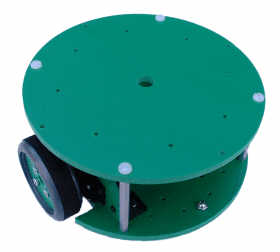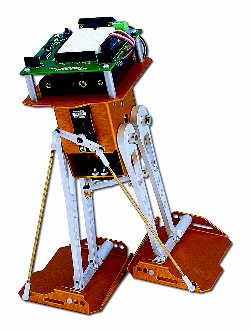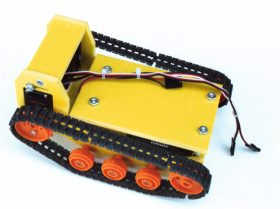Exploring Robot Locomotion Systems
Moving Your Robot with Wheels, Tracks, or Legs
Locomotion involves the conversion of some source of energy — electricity, air pressure, steam, nuclear power. — into a mechanical action that moves a vehicle or other carriage. Consider the lowly car: gas you put into the tank is converted to mechanical power by means of internal combustion. The gas is compressed as a vapor and explodes against a cylinder. The explosion pushes the cylinder down; this cylinder is in turn is connected to a drive shaft, which spins the wheels. The process repeats itself thousands of times per minute.
Mobile robots use a variety of techniques to achieve motion. Most use an electric power source (usually a battery) that operates an electric motor. In the typical arrangement the direction of the motors can be changed, allowing the robot to be propelled forward or backward. There are other power train techniques used for robots, but the battery and motor pair is by far the most common.
Wheels

Wheels are the most popular method of providing robot mobility. Robot wheels can be just about any size, dictated only by the dimensions of the robot and your outlandish imagination. However, for reasons of practicality and weight, small robots usually have small wheels, less than two or three inches in diameter. Medium sized robots use wheels with diameters up to seven or eight inches. A few unusual designs call for bicycle wheels, which despite their size, are lightweight but very sturdy.
Robots can have just about any number of wheels, although two is the most common. The robot is balanced on its wheels by one or two skids or swivel casters. Four and six?wheel robots are also around. The most common robot uses two drive wheels. placed on either side.
Legs
A small percentage of amateur robots are designed with legs, and such robots can be conversation pieces all of their own. Many difficulties must be overcome in designing and constructing a legged robot. First, there is the question of the number of legs, and how the legs provide stability when the robot is in motion. Or more critical, stability when it’s standing still. Then there is the question of how the legs propel the robot forward or backward — and more difficult still! — the question of how to turn the robot so it can navigate a corner.

Legged robots are a challenge to design and build, but they provide an extra level of mobility that wheeled robots cannot. Wheel-based robots may have a difficult time navigating through rough terrain, but a properly designed leg-based robot can easily walk right over small ditches and obstacles.
A few daring robot experimenters have come out with two-legged robots, but the difficulties in assuring balance and control make these designs largely impractical for most robot hobbyists. Exception: the robot uses wide “duck” feet, and waddles as it walks. With this arrangement, however, turning can be inexact.
Four-legged robots (quadrupeds) are easier to balance, but good locomotion and steering can be difficult to achieve. I’ve found robots with six legs (called hexapods) are able to walk at brisk speeds without falling, and are more than capable of turning corners, bounding over uneven terrain, and making the neighborhood dogs and cats hide for cover.
Robots with legs add many complexities. If you’d like to learn more about legged robots check out Robot Builder’s Bonanza, Fourth Edition.
Tracks
The basic design of track?driven robots is simple: two tracks, one on each side of the robot, act as giant wheels. The tracks turn, and the robot lurches forward or backward. For maximum traction, each track is the same length, or somewhat shorter, than the length of the robot itself — though many variations are possible.

Track drive is practical for many reasons, including the ability to mow through all sorts of obstacles, like rocks, ditches, and potholes. Given the right track material, traction is excellent, even on slippery surfaces like snow, wet concrete, or a clean kitchen floor.
For the most part, constructing and effective track drive is harder than implementing wheels. The reason: the tracks present a large contact area. This larger contact area increases traction when moving forward or backward, but it also restricts turning. Tracked vehicles, like tanks, turn by skidding or slipping around a turning point — hence they are referred to as having skid-steering. If the treads are super-pliable, and the surface is hard (like a kitchen floor), the added friction can greatly impair the ability of the vehicle to turn.